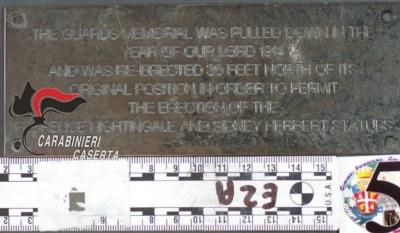'International kleptomaniac' stole from British Museum, police say

ROME — Six months after the British Museum announced that it had overlooked the theft of some 1500 objects from its collection, Caserta carabinieri charged a Castel Volturno man with cultural heritage crimes for a number of art thefts abroad — including stealing from the British Museum.
Police have not released the accused man’s name. Naples daily Il Mattino quoted police describing him as an unemployed 42-year-old.
Carabinieri began investigating the man after security footage from last March captured him stealing from the Reggia di Caserta, the main palace used by the House of Bourbon-Two Sicilies during their reign as kings of Naples.
Cameras recorded the man entering the Palazzo’s Sala delle Battiglie. He crossed a floor tile, stopped, retraced his steps, bent down, pried the 19th-century tile from the floor, and slid it into a yellow envelope, police said. He then continued with his visit, for which he paid the price of regular admission.
Carabinieri subsequently began tracking the 42-year-old’s movements. Eventually they searched his home, where they found a wooden chest stuffed with art and artifacts stolen from a host of sites in Italy and abroad.
The man had accumulated mostly coins, commemorative plaques, and fragments of statues from museums and squares around London, police said. He had packaged every object separately, bundled with relevant museum catalogs or site guides and labeled with its place of origin.
As their investigation is still ongoing carabinieri have not disclosed the full list of recovered objects or of places to which the art thief traveled. They have returned the Reggia di Caserta's floor tile to the care of the Palazzo, they said. They detailed two additional finds: a bronze plaque the collector unscrewed from the Guards Crimean War Memorial in London's Waterloo Square, and a plaque he lifted from the British Museum’s 18th-century terracotta bust of botanist John Ray.
The British Museum caused a major scandal last August when it announced that in 2021 it had incorrectly concluded that there was “no basis” to alarm bells about the theft of and damages to thousands of items in its collection.
In fact roughly 2000 items — the vast majority of which were gems and jewellery in the museum’s Department of Greece and Rome, the museum said — had indeed been stolen or damaged.
Director of the museum Hartwig Fischer resigned and accepted responsibility for widespread security failures. An independent investigation ordered by the museum’s trustees has led to new security and cataloguing protocols for the institution.
Chair of trustees George Osborne had since alleged that the museum was the “victim of an inside job." The Times identified the alleged thief as Peter John Higgs: former head curator of Greek and Roman art. Higgs spent more than 30 years at the British Museum before an anonymous antiquities expert browsing eBay noticed an account — whose PayPal linked to Higgs' twitter — peddling items from the British Museum's collection. The eBay seller had listed one Roman onyx carving valued at between 25,000 and 50,000 pounds for only 40, the Times reported. The British Museum fired Higgs last summer.
The British Museum most recently announced that with the help of the public and Metropolitan Police, it had recovered 351 stolen items. Now Caserta carabinieri have added at least one more to the tally.
© COPYRIGHT ITALIAN INSIDER
UNAUTHORISED REPRODUCTION FORBIDDEN


